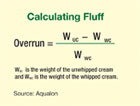
Stabilizing Organic Products
The organic food market surpassed $15 billion in sales at the end of 2005. Organic dairy sales have grown over 30% annually for the past three years. Ted Benic, dairy program manager for TIC Gums, conversed about organic dairy stabilization. He explained organic market growth, rules and regulations, dairy products, gums and emulsifiers, and the basics for stabilization of dairy products.Organic regulations can be found in 7 CFR 205.300 to 205.311, stating that “100% organic” must contain by weight or fluid volume (excluding water and salt), 100% organically produced ingredients. “Organic” must contain a minimum of 95% organically produced ingredients. “Made with organic” must contain 70% organic ingredients. To be considered organically produced, it must contain natural ingredients. If an organic source of an ingredient is available, it must be used. Products must be at least 95% to 100% organic to use the USDA seal.
Organic dairy products include milk, ice cream, yogurt, cheese, cream cheese, buttermilk, sour cream, cottage cheese, beverages, ices and sorbets. 100% organic certified hydrocolloids include guar gum, locust bean gum, gum acacia, and corn and tapioca starches. The 95% organic rule allows for hydrocolloids including agar, alginate, carrageenan, gellan, konjac, pectin, tara and xanthan. Emulsifiers considered 100% organic include lecithin, egg yolk and gum acacia. Single gums work, but better results can be seen using combinations, taking advantage of synergistic effects.
Higher quality organic dairy products can be developed when developers read and comprehend the organic regulations. Understanding gums and the desired finished product characteristics will result in the best combination of ingredients for each product.
“Stabilization of Organic Dairy Products,” Ted Benic, tbenic@ticgums.com, www.ticgums.com. —Summary by Elizabeth Mannie, Contributing Editor

The diagram shows the HPC (red lines) and carrageenan (blue lines) aggregating the casein micelles (white balls) and controlling fat droplet size (yellow balls).
Understanding and Stabilizing Cream
Cellulose derivatives provide key functions in dairy products. Mary Jean Cash, senior staff scientist at Aqualon, described the company’s applications and provided an example in formulating a low-fat whipping cream. Cellulose derivatives include cellulose gum, methylcellulose, hydroxypropylmethylcellulose and hydropropylcellulose.Cellulose gum provides viscosity; in ice cream, it controls meltdown and ice crystal growth. In dairy beverages, it stabilizes protein at low pH. Methylcellulose and hydroxypropylmethyl cellulose are surface active in sherbet, enhancing overrun. They provide thermal gelling in cream fillings and prevent boil-out during baking of pastry. Hydroxypropylcellulose is surface active in whipped topping, promoting and stabilizing foams.
Whipped cream is a foam with water as the continuous phase. The dispersed phases are fat and casein. Emulsifiers are needed in lower fat whipping creams to stabilize oil droplets and control particle size. Hydrophilic/water-soluble stabilizers maintain a stable emulsion.

By calculating overrun, one can determine how much air has been incorporated into a given volume of product.
The desirable properties of whipped cream include white color, high stiffness, an increased amount of overrun and a whipping time of three minutes. Stability of stiffness, drainage, appearance for 24 hours and a reduced fat level are other positives. Overrun is a measure of air incorporation and is calculated as seen in the chart “Calculating Fluff.” Stiffness is measured by texture analysis, stability is measured by a drainage test and appearance is a subjective visual analysis.
Carrageenan interacts with Ca++ in the cream, forming weak gels. Carrageenan stabilizes by building a network, reducing or eliminating phase separation in liquid cream. Microcrystalline cellulose (MCC) increases viscosity in the continuous phase, which stabilizes the foam. However, it does not promote foam, since it is not surface active. Carboxymethyl cellulose (CMC) increases viscosity. CMC interacts with protein and may destabilize dairy systems when the pH is near neutral. Guar gum provides only viscosity and may also bring undesirable flavors. Salts can increase casein solubility but may deter whipping.
Hydroxypropylcellulose (HPC) stabilizes cream foams, aiding in fat aggregation during whipping by reducing surface tension at the air-water interface. This is achieved by forming an elastic film at the interface. HPC also aggregates denatured protein in the aqueous network and at the fat interface.
“Formulating Low-fat Dairy Foods with Cellulose Derivatives,” Mary Jean Cash, Aqualon, MCash@herc.com, www.aqualon.com —Summary by Elizabeth Mannie, Contributing Editor
Healthy Indulgent Ice Cream
Healthy ice cream enjoys consumer acceptance, as shown by the increasing number of product launches in this category. Benjamin Moser, associate program coordinator of applications at Roquette America Inc., explained that healthy ice cream is ready to reach the next level, beyond sugar and fat reduction to balanced nutrition in indulgent products. Healthy ice cream formulations can be improved through functional and physical property synergies. Taste is always number one, and innovative ingredient suppliers are key to success of new products. Joint manufacturer/ supplier innovation is highly recommended for effective new product innovation.Consumers want improved health without sacrifice. Taste remains the top consumer driver, with continued importance in reducing calories, sugar and fat. There is also an emerging interest in soluble fiber, extended energy and intestinal health.
Good-tasting formulations with enhanced nutritional performance will provide excellent growth for new and existing brands. The market is also demanding convenience for life simplification. Consumers desire to manage their weight by eating on-the-go versus sitting down for meals. Reduced-calorie convenience snacks will be expected to deliver added nutrients and health benefits. Healthy ice cream novelties will provide nutrition on the go. However, without a full-fat mouthfeel, full-sugar sweetness, excellent flavor release and gastric tolerance, repeat sales are doubtful.
Healthy sugar replacers provide opportunities to meet emerging consumer demands. Reduced-calorie, low-calorie, reduced-sugar, sugar-free, no-sugar-added and light are some of the claims currently being made on healthy ice cream products. New ingredient technologies will offer additional options such as prebiotic effects and “good source of fiber” claims.
Indulgent taste in healthy ice cream is complex. Full sugar sweetness currently relies on the use of high-intensity sweeteners like aspartame, ace-K and sucralose. Fat reduction/elimination relies on stabilizers and gum systems and synergies with bulk sugar replacers. Mouthfeel relies on balanced stabilizer and bulk sugar replacement system application. Scoopability and melt characteristics depend largely on control of freezing point depression with non-sugar components.
Current healthy ice cream formulations are based on a multiple ingredient approach. Sugar alcohols (polyols) are key bulk sugar replacers in no-sugar-added ice cream. Polyols are reduced-calorie saccharide derivatives in which the carbonyl group of a sugar has been reduced to an alcohol (e.g., maltitol, sorbitol and lactitol). These products also include polymeric syrups such as maltitol syrups and hydrogenated starch hydrolysates. Polyols provide sweetness and texture functionality, while offering improved nutritional performance over sugar-based products.
Typical no-sugar-added ice cream ingredients depend on synergistic performance. Maltodextrin, polydextrose, sorbitol, high-intensity sweeteners and lactitol are ingredients used to produce an acceptable product but cannot be used by themselves in no-sugar-added ice cream. Taste, tolerance and low glycemic performance can be improved.
Soluble fiber enhancement through advanced raw materials (such as dextrin-based polyol systems) allows for the elimination of both sugar and fat with improved organoleptic and nutritional attributes. Fiber also offers glycemic reduction attributes with improved gastric tolerance. The fiber source must be thermally stable to survive dairy processes.
New technology must offer outstanding benefits to meet healthy market demands. Consumers continue to expect more health benefits than currently provided in existing no-sugar-added ice cream, and the technology to bring these formulations is now available.
New Innovations in Healthy Ice Cream Formulations,” Benjamin Moser, Roquette America Inc.,ben.moser@ roquette.com, www.roquette.com.
—Summary by Elizabeth Mannie, Contributing Editor
Enhancing Cheese Appeal
Flavored cheeses are key to market growth, explained John Lasin, senior food technologist-savory applications, at International Flavors and Fragrances. Flavored cheeses can expand consumption via new taste experiences. Keeping in step with changing demographics and market needs, flavored cheese can enhance healthy eating opportunities. New market segments are created by utilizing flavors targeted to appeal to specific age or cultural groups. For example, products combining innovative flavors with fun-to-eat and on-the-go snack foods can be targeted to kids.Flavored cheeses increase opportunities to eat cheese with new breakfast items and dessert-type products. Controlled delivery of hot and spicy flavors and extending the variety of traditional foods containing cheese are two more reasons flavored cheeses help increase market growth.
Flavors can simplify innovative cheese production. Combining flavors with cheese in a single component is an easy process. Multiple varieties can be delivered from a standardized cheese formula. Flavoring in the cheese matrix provides consistent taste delivery. Flavor impact is increased through concentrated systems.
Flavor addition to cheese curds needs optimized procedures for flavor uniformity and retention. Solubility criteria for different types of cheeses need defining. Building a cheese base that effectively delivers sweet and fruit flavors also has been a challenge.
Modifying cheese composition to deliver flavors effectively requires a balanced salt content, the appropriate appearance and color attributes, optimum flavor release and masking, and uniform flavor delivery after secondary processing.
Current products where flavors are used include seasoning mixtures in Monterey Jack cheeses; fruit, salmon and warm brown flavors in cream cheese spreads for bagels; flavored cheese shreds for pizza and taco toppings; and cracker spreads using processed cheeses.
Further growth opportunities include stuffed bread sticks and pizza crusts that deliver more flavor variety. Cheese toppers for home prepared dishes and line extensions to traditional port and wine cheddar spreads also show promise. Other areas of consideration are in delivering seafood and nut flavors in allergen-free forms and customized smoky flavor profiles such as grilled, barbecue or pan-fried foods.
“Cheese Innovation Through Flavor Technology,” John Lasin, International Flavors and Fragrances, john.lasin@iff.com, www.iff.com.
—Summary by Elizabeth Mannie, Contributing Editor